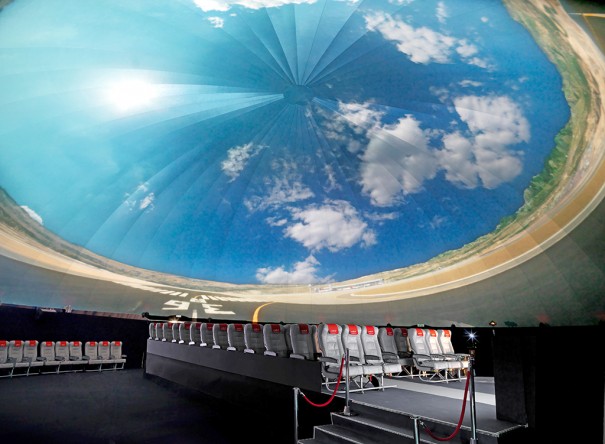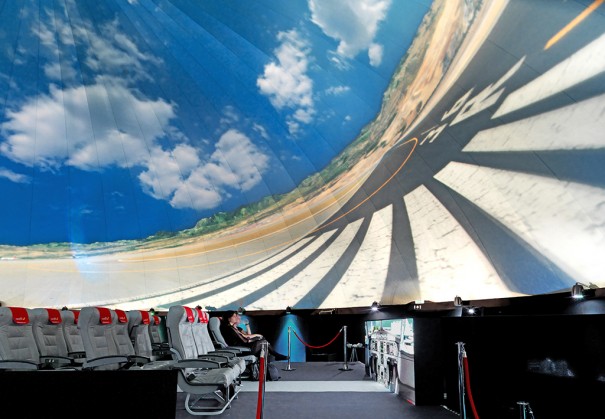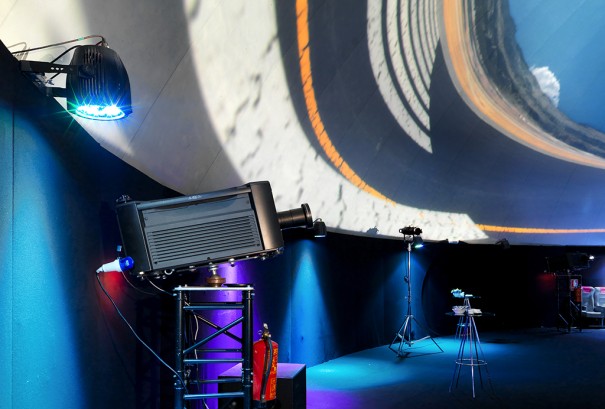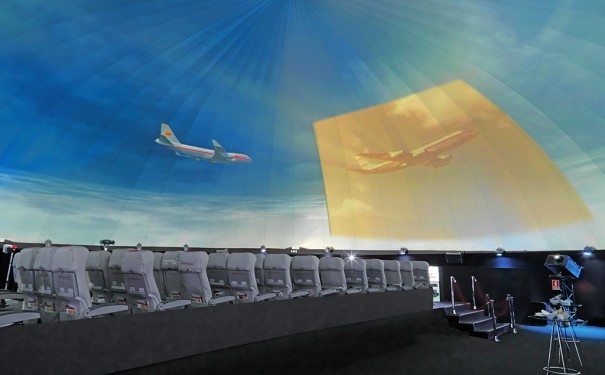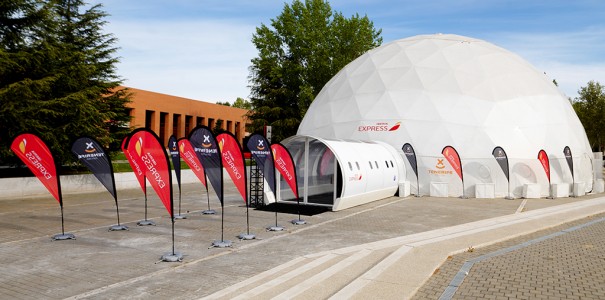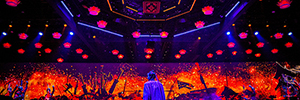Iberia Express celebra sus logros con la proyección de un vuelo virtual entre Madrid y Tenerife
Para la proyección virtual en 360º, Newmedia utilizó un domo geodésico con 6 proyectores Christie Roadster HD20K-J, así como un reproductor Delta Media Server de 7thSense para el procesamiento de la imagen, Medialon para gestionar los periféricos y un panel plano LCD FHD461-X para simular la pantalla de una puerta de embarque.
Iberia Express celebra que ha alcanzado los 10 millones de pasajeros en tres años y que ha sido reconocida por la industria con el premio a la ‘aerolínea de bajo coste más puntual del mundo’ organizando un vuelo virtual entre Madrid y Tenerife. Para realizar esta proyección utilizó un domo de 360 grados proporcionado por el especialista de eventos en directo Newmedia Creative Technology Studio y Christie.
Convertido en un auténtico avión de Iberia Express, el domo de Newmedia fue durante tres días el escenario de múltiples sesiones de entrada libre y gratuita en las que, en un recorrido por la historia de la aviación y los logros de la compañía durante estos tres primeros años, cientos de pasajeros pudieron embarcar en un viaje virtual con destino a la isla de Tenerife.
“Queríamos un evento que nos permitiera comunicar esos dos hitos de una manera innovadora tecnológicamente, ya que es uno de los puntos que definen una parte de nuestro ADN y en la que trabajamos activamente, buscando siempre productos que nos hagan destacar en ese ámbito”, dice Paloma Utrera, responsable de Ventas de Iberia Express.
El mayor desafío fue generar un realismo que la audiencia pudiera experimentar estar dentro de un avión y la sensación de volar.
“Hicimos una simulación virtual mediante la utilización de un sistema de realidad virtual Oculus Rift que fijamos a un punto concreto y, de esa forma, simular lo que luego sería la plataforma o fuselaje del avión. Then, mediante la creación de una película en 360º en tiempo real, íbamos modificando o cambiando el ecuador de la película para testear la sensación del despegue y aterrizaje, que sin lugar a dudas era el talón de Aquiles de este viaje virtual. Una vez que vimos que esto era posible lo llevamos a la escala de un Airbus A320”, explica Diego De Anna, CEO de Newmedia.
Newmedia utilizó un domo geodésico con sistema de proyección interna mediante presión negativa de 21,7 meters in diameter and 11 de altura con una superficie aproximada de 364 Square meters.
En el interior de esta estructura se recreó a tamaño real una parte del fuselaje de un Airbus A320, el avión insignia de la compañía. Montados sobre una plataforma que disponía de un sistema de vibración por sub-graves, 90 asientos reales cedidos por Iberia Express daban vida al avión.
Los invitados eran recibidos como si llegaran a un aeropuerto y conducidos al domo a través de un túnel vidriado que simulaba ser el fuselaje del Airbus. Una vez dentro y acomodados en sus asientos, el personal del aparato impartía las recomendaciones de seguridad habituales en todos los vuelos.
Next, mediante un sistema de vibración en sincronía con la proyección de imágenes en 360 degrees, se generaba la sensación entre los asistentes de que el aparato se movía y despegaba. Una vez en el ‘aire’, tras el clásico saludo e indicaciones del capitán del vuelo, se proyectaban imágenes de Tenerife, así como una producción audiovisual con la historia y logros de Iberia Express. Y mediante un sofisticado manejo de imágenes reales y generadas por ordenador, la audiencia pudo recrear una situación de vuelo real.
Un vuelo inmersivo en 360º
Para la puesta en escena de este proyecto se utilizaron seis proyectores Christie Roadster HD20K-J con los que se creó el ambiente inmersivo del domo, trabajando a una resolución de casi 3K con más de 12 Millions of pixels.
Con cinco equipos distribuidos de forma simétrica se realizó la base y ecuador de la proyección, y con un sexto la cúpula propiamente dicha, lo cual permitió tener una proyección 360º x 180º.
Los seis proyectores estaban situados sobre estructuras truss a dos metros de altura y montados sobre una rótula que Newmedia diseñó especialmente y que permitía ajustar entre 0º/65º el ángulo necesario.
El reproductor Delta Media Server de 7thSense se utilizó para el procesamiento de la imagen, que fue secuencia TGA sin comprimir 4.4.4. También se usó Medialon como sistema de control para gobernar periféricos y se instaló un panel plano LCD Christie FHD461-X en el exterior del domo para simular la pantalla de una puerta de embarque señalando la hora y el destino del vuelo.
El uso del blending y warping fue clave para encajar la proyección de forma precisa en la superficie irregular sobre la que se proyectaba.
“De hecho, este sistema de proyección es tan complejo que en algunos lugares convergen hasta más de cuatro puntos de blending, cuatro haciendo blending en un mismo punto y sobre una superficie curva”, explica Diego De Anna. “Tanto el blending como el warping los realizamos de forma externa desde nuestro servidor Delta, pero lo hicimos así por el tema de la corrección polar y el autoaligment”.
La superficie de proyección fue de 800 metros cuadrados y la resolución de 2.700×2.700 Pixels, that is to say, cercana al 3K. Los contenidos proyectados incluyeron secuencias CGI, imágenes rodadas en 360º, vídeos convencionales en 4K y material de archivo cedido por Iberia Express.
[youtube]https://www.youtube.com/watch?v=uC7U0Mm4pOI[/youtube]
You liked this article?
Subscribe to us RSS feed And you won't miss anything.
• Section: Thoroughly, Study cases, Control, OUTSTANDING, Display, Projection, Simulation



